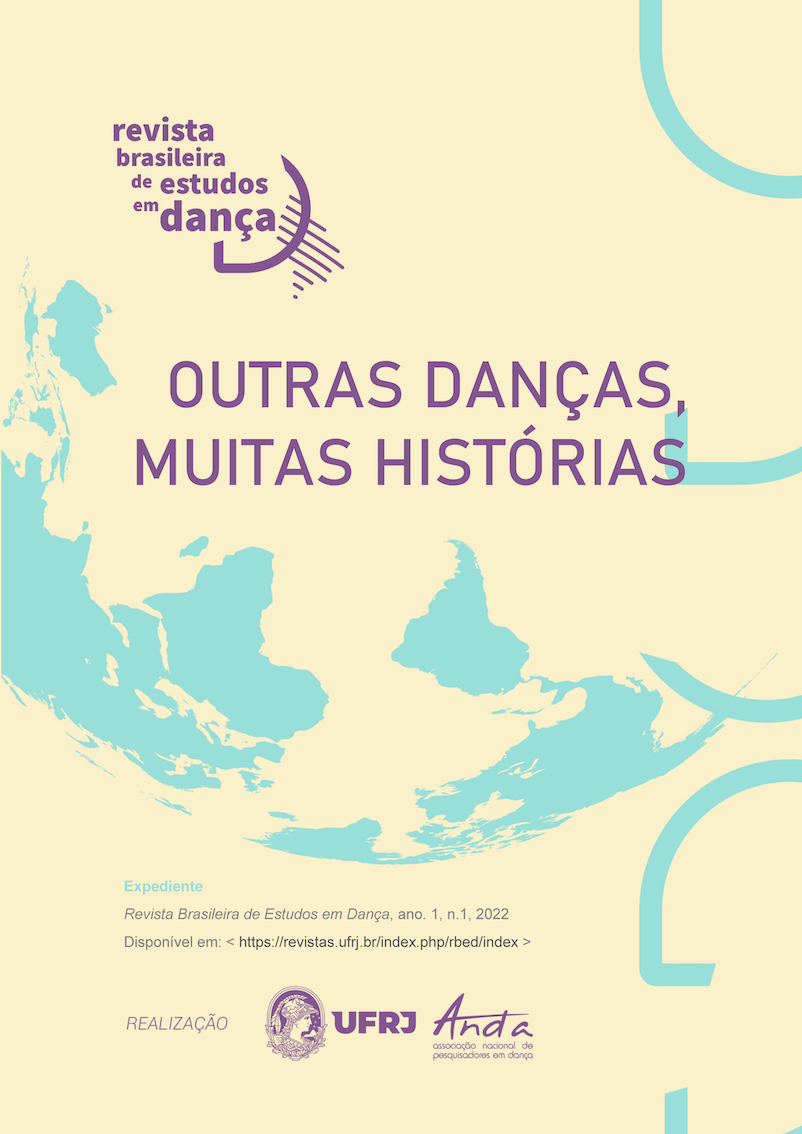Fragments and absences:
modos de existência das atividades de ensino e produção coreográfica na cidade de Florianópolis (SC) entre as décadas de 1940 e 1980.
DOI:
https://doi.org/10.58786/rbed.2022.v1.n1.53223Keywords:
História da Dança, Florianópolis, DançaAbstract
The historical context of the development of teaching activities and choreographic production in the city of Florianópolis, capital of the State of Santa Catarina, is the focus of this article. From fragments and absences, a journey that starts from classical ballet as a reference for dance production in the 1940s and goes all the way to the first contemporary productions of the 1980s. An approach to the constitution of this municipality since the 16th century, from the perspective of its colonization process and migratory flows, was included to highlight the development of dance in the specificity of its environment and in its different historical moments.
References
BREHSAN, Nastaja Roussenq. A formação de bailarinas e bailarinos contemporâneos em Florianópolis. 2007. Trabalho de Conclusão de Curso (Graduação em Artes Cênicas) - Universidade do Estado de Santa Catarina, Florianópolis, 2007.
COLLAÇO, Vera. Um teatro para o trabalhador de Florianópolis. In: FLORES, Maria B. R., LEHMKUHL, L., COLLAÇO, V. (org.) A casa do baile. Estética e modernidade em Santa Catarina. Florianópolis: Fundação Boiteux, 2006. p. 211-236.
CORRÊA, Carlos Humberto P. História de Florianópolis - Ilustrada. Florianópolis: Insular, 2005. 2a ed.
FLORES, Maria B. R. Estética e Modernidade: à guisa de introdução. In: FLORES, Maria B. R., LEHMKUHL, L., COLLAÇO, V. (org.) A Casa do Baile. Estética e Modernidade em Santa Catarina. Florianópolis: Fundação Boiteux, 2006. p. 11-38.
FOSSARI, Teresa Domitila. Cultura pré-histórica da Ilha de Santa Catarina. In: MELO Osvaldo Ferreira de (org.) História Sociocultural de Florianópolis. Florianópolis: Clube Doze de Agosto / I.H.G.S.C, Lunardelli, 1991.
LUNARDELLI, Daniel H, França. A Cidade Milagre: novos contornos de uma Florianópolis em vias de modernização. Cadernos NAUI. Vol. 2, n. 2, jan -jun 2013.
MEYER, Sandra. Novos tempos para a dança nos anos 1970. In: MEYER Sandra, NORA, Sigrid e PEREIRA. Roberto (org.) Seminários de Dança - História em Movimento: biografias e registros em dança. Caxias do Sul: Lorigraf, 2008. p.103 - 116
NUNES, Sandra Meyer. A Dança Cênica em Florianópolis. Florianópolis: Fundação Franklin Cascaes, 1994. (Cadernos de Cultura e Educação, n° 2).
SIMÃO, Charlene. A cena da dança contemporânea em Florianópolis - 1972 a 2008: vestígios e reverberações. 2008. Monografia (Graduação). Universidade do Estado de Santa Catarina, Centro de Artes, Curso de Artes Cênicas, Florianópolis, 2008.
SIMÃO, Charlene e BREHSAN, Nastaja. In: XAVIER, Jussara, MEYER, Sandra e TORRES, Vera. (org.) Histórias da Dança (Coleção Dança Cênica, vol. 2). Florianópolis: Editora da UDESC, 2012. p.121-140
XAVIER Jussara. Ballet Desterro: contemporaneidade na dança catarinense, DVD, documentário, FUNARTE : Florianópolis/SC, maio de 2010.
XAVIER Jussara. Ballet Desterro: contemporaneidade na dança catarinense In: XAVIER, Jussara, MEYER, Sandra e TORRES, Vera. (org.) Histórias da Dança (Coleção Dança Cênica, vol. 2). Florianópolis: Editora da UDESC, 2012. p.141-171
Published
Versions
- 2024-05-10 (3)
- 2023-11-30 (2)
- 2022-07-29 (1)
How to Cite
Issue
Section
License
Authors who publish in the Revista Brasileira de Estudos em Dança are
responsible for the content of signed articles and retain copyright.
They grant the journal the right of first publication with the work simultaneously
licensed under the Creative Commons Attribution-NonCommercial 4.0 License
(Open Archives Initiative - OAI). This feature, used for open-access journals,
allows sharing work for non-commercial purposes and acknowledges
authorship. If the text is later published in another vehicle, the author
must inform that it was initially published as an article in the Revista Brasileira
de Estudos em Dança. Therefore, even if the journal owns the first publication,
authors are entitled to publish their work in institutional repositories or on
their personal pages, even if the editorial process has not been completed.
The journal reserves the right to make normative, orthographic, and grammatical changes to maintain the language standard, respecting the authorial style.

